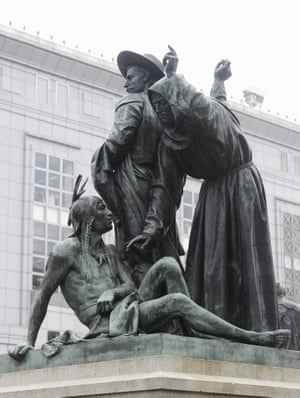Below are a few resources surrounding the recent removal/destruction of statues.
“The world does not need statues, relics of another age, that reflect neither the values of the person they intend to honor nor the values of equality and justice,” said Theodore Roosevelt IV, age 77, a great-grandson of the 26th president and a museum trustee.
From the artist, John Russell Pope, in 1928:
“In the center of the terrace…will arise a polished granite pedestal bearing an equestrian statue of Roosevelt with two accompanying figures on foot, one representing the American Indian and the other the primitive African. This heroic group…will symbolize the fearless leadership, the explorer, benefactor and educator….”—From a description of the architect’s design approved by the Memorial Commission, 1928
Commenting on the recent controversy: “Pope refers to the figures as a ‘heroic group.’ That’s important. In some criticisms, the standing figures were taken to be lesser than Roosevelt. That was never the intention. They are allegorical figures representing Africa and America, emphasized by the animals on the parapet reliefs.”—Harriet F. Senie, Director, M.A. Art History, Art Museum Studies, The City College of New York
What’s the point of statues?
To the minds of people in the eighteenth and nineteenth centuries, public art had a very clear purpose, which seems to have been forgotten in the minds of many people today. Rather than teaching history, or even celebrating the memory of a particular person, so much of the art that still dots our public places was explicitly about inculcating virtue – good morals, and good habits.
It’s a notion that sits uneasily with us now. It’s hard to think of any artist today who would be so bold as to tell us all how we should think and act.
https://fl.ink/explore/whats-the-point-of-statues
Some Statues Are Like Barbed Wire
Activists fighting to remove statues of slavers and colonizers understand better than most how public memorials can be a form of violence.
Thinking about how and why statues go up might help us to think about if they should come down. Once a statue is in place, it is easy to think of it as an eternal and inevitable presence—a view that informs the notion that removing statues is tantamount to “erasing history.” However, statues don’t happen by accident; it takes the concerted will and money of an individual or group to have a monument take form in stone or metal in a public place. Thinking through the intentions of how, where, and when a given statue came to exist in a given space at a given time offers a way past scaremongering about slippery slopes and the erasing of history to consider the story a statue tells, and if that is a story that belongs in a public place in 2020.
https://bostonreview.net/race/jonathan-beecher-field-some-statues-are-barbed-wire?utm
Foreign Affairs Magazine January/February 2018 The Undead Past
An excellent collection of articles discussing the role of history and memory and how different nations including the U.S., Russia, China, Germany, Rwanda, and South Africa have dealt with their pasts.
From the introduction to the issue:
How do nations handle the sins of the fathers and mothers? Take genocide, or slavery, or political mass murder. After such knowledge, what forgiveness—and what way forward? The Germans have a word for it, of course: Vergangenheitsbewältigung, or “coming to terms with the past.” But the concept is applicable far beyond the Nazis
https://www.foreignaffairs.com/issues/2018/97/1(may be behind a paywall)
Here are a bunch more posts about historical monuments and history.
https://toktopics.com/tag/monuments/


 When we choose how we view history, we risk mythologizing events and people, reducing them to two-dimensional stories. It takes nothing away from Abraham Lincoln’s heroic stewardship of our nation through the Civil War, for instance, to admit that he was still a creature of his era. For most of his career, he saw slaves as rival laborers for white wage-workers and thought they should go back to Africa. Frustratingly, our instinct to sanitize history ensures that we are always looking backward for our better angels, struggling to meet a standard that remains forever out of reach.
When we choose how we view history, we risk mythologizing events and people, reducing them to two-dimensional stories. It takes nothing away from Abraham Lincoln’s heroic stewardship of our nation through the Civil War, for instance, to admit that he was still a creature of his era. For most of his career, he saw slaves as rival laborers for white wage-workers and thought they should go back to Africa. Frustratingly, our instinct to sanitize history ensures that we are always looking backward for our better angels, struggling to meet a standard that remains forever out of reach.